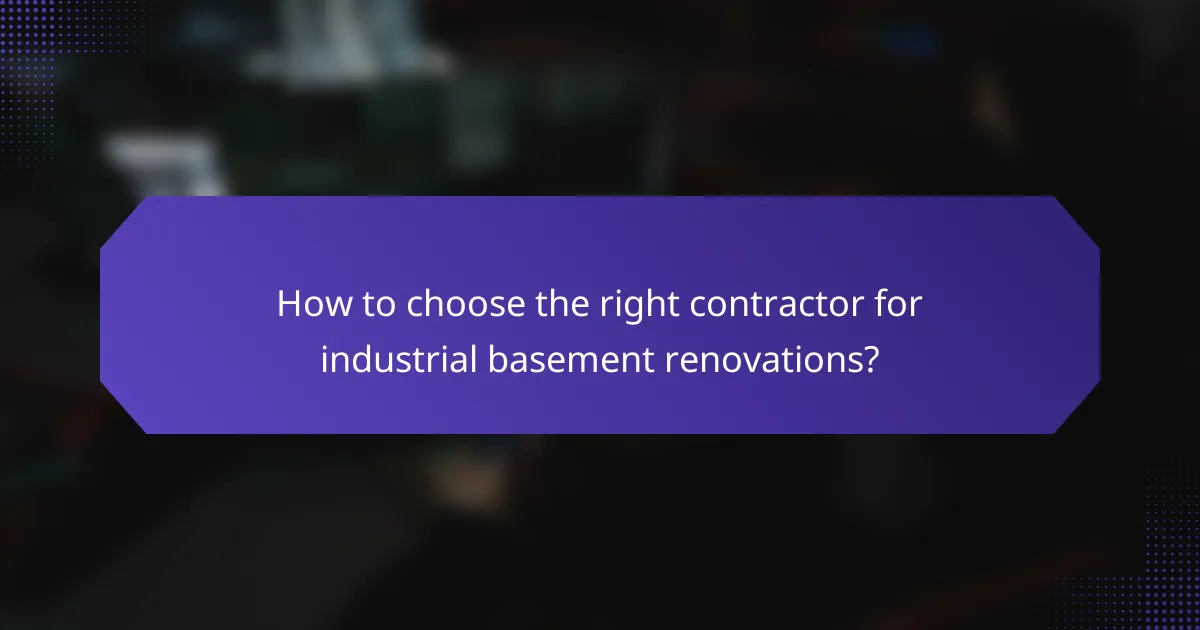Transforming your basement into an industrial haven with exposed brick and metal accents can create a striking urban vibe. This design style not only highlights the raw beauty of materials but also ensures a functional and comfortable space, perfect for modern living. Embrace the unique aesthetics and durability of this approach to enhance your home’s character.

How to design an industrial basement with exposed brick and metal accents?
Designing an industrial basement with exposed brick and metal accents involves blending raw materials with a modern aesthetic. Focus on creating a cohesive look that highlights the character of the space while ensuring functionality and comfort.
Incorporate reclaimed materials
Using reclaimed materials is essential for achieving an authentic industrial vibe. Consider sourcing items like salvaged wood beams, vintage metal fixtures, or repurposed furniture to add unique character to your basement.
Look for local suppliers or online marketplaces that specialize in reclaimed materials. This not only supports sustainability but also helps you find distinctive pieces that tell a story.
Utilize open floor plans
An open floor plan enhances the spacious feel typical of industrial designs. Aim for a layout that minimizes walls and barriers, allowing for fluid movement and versatile use of the space.
Consider multifunctional furniture that can adapt to various activities, such as a large table for gatherings or a cozy seating area for relaxation. This approach maximizes usability while maintaining an airy atmosphere.
Choose bold color palettes
Bold color palettes can energize an industrial basement, contrasting beautifully with the raw textures of exposed brick and metal. Opt for deep hues like navy, charcoal, or forest green to create a striking backdrop.
Incorporate pops of color through accessories, artwork, or accent walls. This balance helps maintain the industrial aesthetic while adding warmth and personality to the space.
Integrate industrial lighting fixtures
Industrial lighting fixtures are crucial for enhancing the overall design and functionality of your basement. Look for options like pendant lights, Edison bulbs, or metal sconces that reflect the industrial theme.
Ensure that your lighting choices provide adequate illumination for various activities, from reading to entertaining. Layering different types of lighting, such as ambient, task, and accent, can create a dynamic and inviting atmosphere.

What are the benefits of an industrial basement style?
The industrial basement style offers a blend of unique aesthetics, durability, and versatile usage options, making it a popular choice for urban living spaces. This design approach emphasizes raw materials like exposed brick and metal accents, creating a modern yet rustic atmosphere.
Unique aesthetic appeal
The industrial basement style is characterized by its striking visual elements, such as exposed brick walls, metal beams, and concrete floors. This raw, unfinished look adds character and charm, appealing to those who appreciate an urban vibe.
Incorporating vintage furniture and industrial lighting fixtures can enhance the aesthetic further, creating a cohesive design that feels both contemporary and nostalgic. This style works well in lofts, converted warehouses, and modern homes seeking a distinctive flair.
Enhanced durability
Materials commonly used in industrial basements, like brick and metal, are known for their strength and longevity. These elements can withstand wear and tear better than traditional finishes, making them ideal for high-traffic areas.
Additionally, the robust nature of these materials often requires less maintenance over time. For instance, brick is less susceptible to damage from moisture compared to drywall, which can lead to mold and deterioration.
Versatile usage options
Industrial basements can serve various purposes, from living spaces to home offices or entertainment areas. The open layout typically associated with this style allows for flexible furniture arrangements and multifunctional spaces.
Consider using modular furniture that can be easily reconfigured to adapt to different needs. This versatility makes industrial basements suitable for both personal and professional use, accommodating everything from casual gatherings to creative workspaces.

What are the costs associated with creating an industrial basement?
Creating an industrial basement can involve various costs, including renovation, materials, and labor. Understanding these expenses helps in budgeting effectively for the project.
Average renovation costs
The average cost for renovating an industrial basement typically ranges from several thousand to tens of thousands of dollars, depending on the scope of work. Factors influencing the total include the size of the space, the extent of structural changes, and the desired finishes.
For a basic renovation, expect costs to start around $10,000, while more extensive projects with high-end materials can exceed $50,000. Always consider obtaining multiple quotes to ensure competitive pricing.
Material price ranges
Material costs for an industrial basement can vary widely based on the aesthetic and functionality desired. Exposed brick can range from $5 to $15 per square foot, while metal accents may cost between $10 and $30 per linear foot.
Additionally, flooring options such as polished concrete or reclaimed wood can add anywhere from $3 to $15 per square foot. Selecting materials that fit both the urban vibe and budget is crucial for a successful renovation.
Labor expenses in urban areas
Labor expenses in urban areas can be significantly higher than in rural locations, often ranging from $50 to $150 per hour. Skilled tradespeople, such as electricians and plumbers, may command premium rates due to demand and expertise.
It’s advisable to budget for at least 20-30% of your total renovation costs for labor. Engaging local contractors familiar with industrial designs can help streamline the process and ensure quality work.

What are the best practices for maintaining an industrial basement?
Maintaining an industrial basement involves regular cleaning and effective moisture control to preserve its aesthetic and structural integrity. Implementing these best practices ensures a functional space that remains visually appealing and safe.
Regular cleaning techniques
To keep an industrial basement looking its best, establish a routine cleaning schedule. Sweep or vacuum dust and debris weekly, and mop the floors with a suitable cleaner to remove stains and grime. Pay special attention to exposed brick and metal accents, as these materials can accumulate dirt and require gentle cleaning methods.
For deeper cleaning, consider using a pressure washer on concrete surfaces, but avoid high pressure on brick to prevent damage. Use a soft brush to clean metal accents, ensuring you don’t scratch the surface. Regularly inspect for signs of mold or mildew, especially in damp areas.
Moisture control methods
Controlling moisture is crucial in an industrial basement to prevent damage and health issues. Start by ensuring proper ventilation; install exhaust fans or dehumidifiers to maintain humidity levels below 60%. This helps inhibit mold growth and keeps the air quality healthy.
Inspect for leaks regularly, particularly around windows and pipes, and seal any gaps with appropriate waterproofing materials. Consider applying a waterproof sealant to walls and floors to provide an additional barrier against moisture intrusion. If flooding is a concern, investing in a sump pump can be a practical solution to manage excess water effectively.

How to choose the right contractor for industrial basement renovations?
Selecting the right contractor for industrial basement renovations involves assessing their expertise, style compatibility, and past work. Focus on contractors who have a strong portfolio in urban designs, especially those featuring exposed brick and metal accents.
Check contractor portfolios
Reviewing contractor portfolios is crucial to gauge their design capabilities and style. Look for projects that showcase industrial aesthetics, such as raw materials, open spaces, and unique layouts. A diverse portfolio indicates versatility and creativity, essential for achieving the desired urban vibe.
Pay attention to before-and-after photos to understand their renovation process and results. This will help you envision how they might transform your basement into a stylish industrial space.
Read client testimonials
Client testimonials provide insight into a contractor’s reliability and quality of work. Seek feedback on their communication, adherence to timelines, and overall satisfaction with the finished project. Positive reviews often highlight the contractor’s ability to meet specific design requests and manage budgets effectively.
Consider reaching out to previous clients for direct feedback. This can give you a clearer picture of what to expect and help you make a more informed decision.
Evaluate experience with industrial styles
It’s essential to choose a contractor who has specific experience with industrial styles. Ask about their familiarity with materials like exposed brick, metal, and concrete, as well as their understanding of urban design principles. Contractors who specialize in these elements are more likely to deliver a cohesive and authentic look.
Inquire about any relevant certifications or training in industrial design. A contractor with a strong background in this area will be better equipped to navigate challenges and ensure your renovation aligns with your vision.

What are the local regulations for basement renovations in urban areas?
Local regulations for basement renovations in urban areas typically include building codes and permitting processes that ensure safety and compliance with zoning laws. These regulations can vary significantly by city, so it’s essential to check with local authorities before starting any renovation project.
Building code requirements
Building codes dictate the structural integrity, safety, and habitability of basement renovations. Common requirements include proper egress windows for safety, adequate ceiling height, and moisture control measures to prevent flooding or mold. It’s crucial to consult the specific codes applicable in your urban area, as they can differ widely.
For example, many cities require a minimum ceiling height of around 7 feet for finished basements. Additionally, electrical and plumbing systems must meet local standards, which may involve using licensed professionals for installation.
Permitting processes
The permitting process for basement renovations usually involves submitting detailed plans to the local building department. This may include architectural drawings, structural calculations, and specifications for materials. The review process can take several weeks, so plan accordingly.
In many urban areas, homeowners must also pay fees associated with the permit application, which can range from a few hundred to several thousand dollars, depending on the scope of the project. Be prepared for inspections at various stages of the renovation to ensure compliance with all regulations.

How to incorporate urban vibes into an industrial basement?
To incorporate urban vibes into an industrial basement, focus on blending raw materials with modern design elements. Utilize exposed brick, metal accents, and a mix of textures to create a dynamic and inviting space that reflects an urban aesthetic.
Utilizing Exposed Brick
Exposed brick is a hallmark of industrial design, providing warmth and character. When incorporating it into your basement, consider leaving sections of the wall bare to showcase the original brickwork, or use a brick veneer for a more uniform look.
To enhance the urban feel, pair the brick with contrasting materials like polished concrete or sleek metal finishes. This combination creates a striking visual balance that emphasizes the industrial theme.
Incorporating Metal Accents
Metal accents can elevate the industrial vibe in your basement. Use materials such as steel, iron, or aluminum for fixtures, furniture, and decor. For example, metal shelving units or light fixtures can add an edgy touch.
Consider using a mix of finishes, such as matte and polished, to create depth. Avoid overwhelming the space with too much metal; instead, opt for strategic placements that complement other design elements.
Creating an Urban Atmosphere
To foster an urban atmosphere, focus on lighting and furniture choices. Industrial-style pendant lights or Edison bulbs can create a warm glow, while minimalist furniture with clean lines can maintain an open feel.
Incorporate artwork or graffiti-inspired decor to add personality and a local touch. Plants can also soften the industrial look, bringing a bit of nature into the urban environment.










